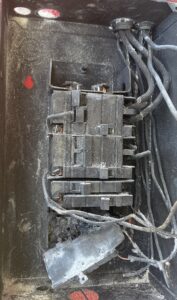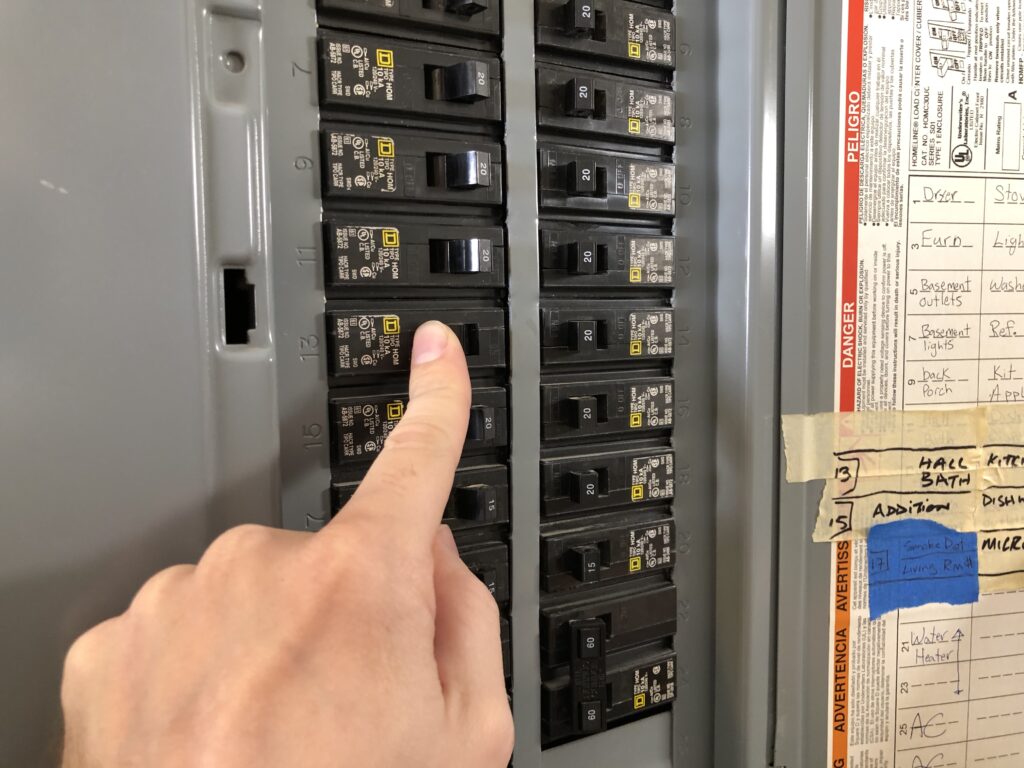If you’re noticing these issues or your power needs have grown, it might be time for an electrical panel upgrade. Use this guide to help you recognize when your panel needs replacing and walk you through the 7 key ways an upgraded panel can improve your home’s safety, comfort, and efficiency for years to come.
How to Know How Much Electricity Your Home Uses
Before deciding if an upgrade is needed, it helps to understand how much electricity your home uses and how that compares to your panel’s capacity. Electrical capacity is measured in amps, which indicate the amount of electric current flowing through your system.
Years ago, most homes needed about 60 amps. Today, many homes operate on 100 amps, while larger homes may need 150 to 200 amps to meet their demands.
Understanding the Risks of an Overloaded Electrical Panel
Panels that weren’t designed for today’s electricity use can become stressed under modern demand. To better understand these issues, here are some key terms you might encounter when discussing electrical panel problems:
Overloaded circuits: A circuit draws more electrical current than it’s built to handle, putting stress on the wiring and potentially causing overheating or breaker failure.
Shorted: A short circuit happens when electricity bypasses its normal path—usually because of damaged wires or loose connections.
Overheating: Excess current or worn components cause too much heat to build up within the system.
Electric arcing: Arcs form when electricity jumps between loose or corroded contact points, generating sparks.

Electrical fires: Fires can occur when heat, sparks, or electrical system failures ignite surrounding materials.
What Happens When Your Panel is Overloaded
As more appliances, devices, and high-powered equipment run simultaneously, the risk of overloaded circuits increases. When this happens, your panel may struggle to distribute electricity safely—especially if it’s outdated or worn.
In some cases, circuits may become shorted, causing electricity to flow along unintended paths. And when components inside the panel begin to wear down, the risk of overheating, electric arcing, or even electrical fires increases.
Why Older Electrical Panels Fall Short
Many older homes in the Twin Cities still rely on electrical panels that were installed decades ago. While they may have worked well at the time, today’s homes demand far more electricity—especially with large appliances, home offices, and EV chargers becoming more common.
Even if your panel seems to be working fine, its age can make it more vulnerable to failure. If it’s more than 25 years old—or if you’re unsure when it was last inspected—it’s a good idea to have a licensed electrician take a closer look. A modern panel can improve both safety and performance while giving your home room to grow.
Warning Signs Your Electrical Panel May Need Attention
Watch for these common signs. If any occur, contact a licensed electrician to inspect your system.
Electrical Shocks, Tingling, or Hot Outlets: These may point to faulty wiring, loose connections, or damaged outlets.
Burning Smell or Visible Sparks: This could signal damaged wiring or overloaded circuits. Also, check for warm or discolored outlets.
Lights That Dim When Appliances Run: A sign that circuits are overloaded and your system can’t meet current power demands.
Frequent Circuit Breaker Trips: Repeated trips or crackling sounds may mean your panel is outdated or failing.
Overuse of Extension Cords or Power Strips: Often a sign that your home doesn’t have enough outlets or circuits, which can raise the risk of fire.
Paying attention to these warning signs can help you avoid costly repairs and keep your loved ones safe.
What’s Included In an Electrical Panel Upgrade:
Upgrading your panel improves your home’s capacity to manage increased power demands both safely and more efficiently.
Common upgrade options include:
Panel Capacity: Increasing your panel’s ability to handle more electricity.
Circuit Breakers & Meter: Adding new breakers and a meter to support higher loads.
Repairs: Repairing or replacing worn or damaged components.
Additional Circuits: Adding circuits to support more outlets.
Hazard Prevention: Replacing faulty circuits to reduce electrical risks.
Code Compliance: Updating wiring and circuits to meet current safety standards.
These options help ensure your electrical system meets today’s demands and keeps your home running smoothly.
7 Benefits of an Electrical Panel Upgrade
Upgrading your home’s electrical panel is one of the smartest moves you can make to keep your family safe and your power reliable. As modern homes demand more electricity than ever, an updated panel not only meets today’s needs but also prepares your home for the future.
Here are 7 smart reasons why scheduling an electrical panel upgrade makes sense now:
Improved Safety: Reduces the risk of electrical fires, shocks, and overloads.
Supports Modern Power Needs: Handles today’s electrical loads, including EV chargers and appliances.
Boosts Home Value: Appeals to buyers and adds resale value.
Protects Electronics: Reduces surges that can damage sensitive equipment.
- Better Efficiency: Can lead to lower electric bills through improved system performance.
Future-Proofing: Prepares for remodels, solar panels, or additions.
Insurance & Code Compliance: May reduce premiums and bring systems up to code.
Upgrading your panel is a smart step toward a safer, more reliable, and more efficient home.
Planning for the Future: Powering Tomorrow’s Home
Upgrading your panel isn’t just about fixing today’s problems—it’s also about being ready for what’s ahead.
If you’re planning to finish a basement, install an EV charger, remodel your kitchen, or add solar panels, you’ll need more electrical capacity. New panels also make it easier to add circuits later without major rewiring. A modern panel gives your home the flexibility to add circuits, support new appliances, and handle future upgrades—while keeping your system compliant with today’s safety standards.
Even if your electrical system seems to be working fine today, think of your home’s future. A panel upgrade now can help prevent delays or complications down the road and help your home grow with your needs. You won’t have to wonder if your current system can support future changes—it will be ready.
What To Expect During an Electrical Panel Upgrade
Upgrading involves skilled electricians working closely with your utility company. Depending on complexity, it can take 8 to 10 hours.
Typical steps include:
Panel Selection: Choosing a new panel size and number of circuits.
Permits & Coordination: Securing permits and coordinating with the utility company.
Power Shut-Off: Temporarily turning off power during the upgrade.
Installation: Installing the new panel and wiring new circuits.
Inspection: Inspection by a state electrical or utility inspector.
Power Restoration: Restoring power once the upgrade is complete.
Knowing the process can help you prepare for a smooth and successful electrical panel upgrade.
Contact a Licensed Electrician—McQuillan Bros Is Here to Help!
Thinking about adding more appliances, charging an electric vehicle, or finishing a basement? Consider how those changes impact your home’s electrical load. An electrical panel upgrade can give you the flexibility and safety you need for whatever comes next.
For a safe, smooth upgrade, trust the experienced electricians at McQuillan Brothers. From inspection to installation, we handle every step—clearly, carefully, and with your home’s safety in mind. Ready to upgrade with confidence? Give us a call today to schedule your evaluation!



